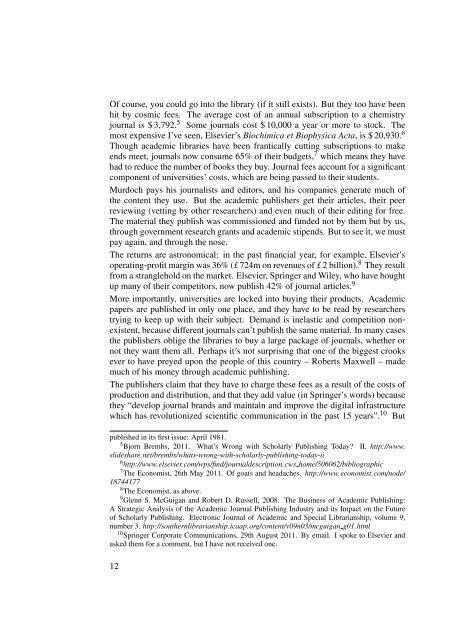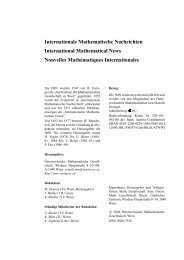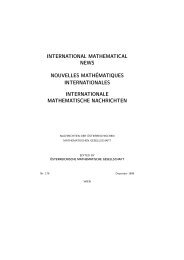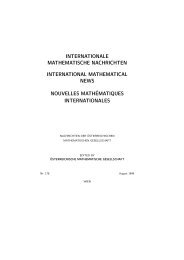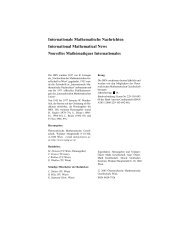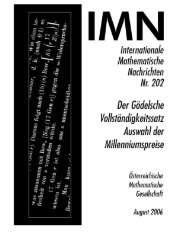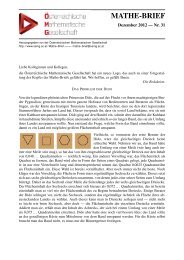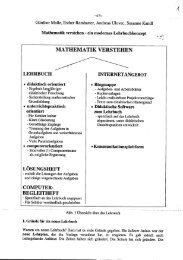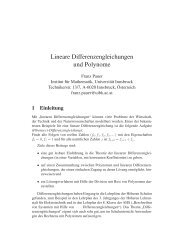218 - Ãsterreichische Mathematische Gesellschaft
218 - Ãsterreichische Mathematische Gesellschaft
218 - Ãsterreichische Mathematische Gesellschaft
Erfolgreiche ePaper selbst erstellen
Machen Sie aus Ihren PDF Publikationen ein blätterbares Flipbook mit unserer einzigartigen Google optimierten e-Paper Software.
Of course, you could go into the library (if it still exists). But they too have been<br />
hit by cosmic fees. The average cost of an annual subscription to a chemistry<br />
journal is $ 3,792. 5 Some journals cost $ 10,000 a year or more to stock. The<br />
most expensive I’ve seen, Elsevier’s Biochimica et Biophysica Acta, is $ 20,930. 6<br />
Though academic libraries have been frantically cutting subscriptions to make<br />
ends meet, journals now consume 65% of their budgets, 7 which means they have<br />
had to reduce the number of books they buy. Journal fees account for a significant<br />
component of universities’ costs, which are being passed to their students.<br />
Murdoch pays his journalists and editors, and his companies generate much of<br />
the content they use. But the academic publishers get their articles, their peer<br />
reviewing (vetting by other researchers) and even much of their editing for free.<br />
The material they publish was commissioned and funded not by them but by us,<br />
through government research grants and academic stipends. But to see it, we must<br />
pay again, and through the nose.<br />
The returns are astronomical: in the past financial year, for example, Elsevier’s<br />
operating-profit margin was 36% (£ 724m on revenues of £ 2 billion). 8 They result<br />
from a stranglehold on the market. Elsevier, Springer and Wiley, who have bought<br />
up many of their competitors, now publish 42% of journal articles. 9<br />
More importantly, universities are locked into buying their products. Academic<br />
papers are published in only one place, and they have to be read by researchers<br />
trying to keep up with their subject. Demand is inelastic and competition nonexistent,<br />
because different journals can’t publish the same material. In many cases<br />
the publishers oblige the libraries to buy a large package of journals, whether or<br />
not they want them all. Perhaps it’s not surprising that one of the biggest crooks<br />
ever to have preyed upon the people of this country – Roberts Maxwell – made<br />
much of his money through academic publishing.<br />
The publishers claim that they have to charge these fees as a result of the costs of<br />
production and distribution, and that they add value (in Springer’s words) because<br />
they “develop journal brands and maintain and improve the digital infrastructure<br />
which has revolutionized scientific communication in the past 15 years”. 10 But<br />
published in its first issue: April 1981.<br />
5 Bjorn Brembs, 2011. What’s Wrong with Scholarly Publishing Today? II. http://www.<br />
slideshare.net/brembs/whats-wrong-with-scholarly-publishing-today-ii<br />
6 http://www.elsevier.com/wps/find/journaldescription.cws home/506062/bibliographic<br />
7 The Economist, 26th May 2011. Of goats and headaches. http://www.economist.com/node/<br />
18744177<br />
8 The Economist, as above.<br />
9 Glenn S. McGuigan and Robert D. Russell, 2008. The Business of Academic Publishing:<br />
A Strategic Analysis of the Academic Journal Publishing Industry and its Impact on the Future<br />
of Scholarly Publishing. Electronic Journal of Academic and Special Librarianship, volume 9,<br />
number 3. http://southernlibrarianship.icaap.org/content/v09n03/mcguigan g01.html<br />
10 Springer Corporate Communications, 29th August 2011. By email. I spoke to Elsevier and<br />
asked them for a comment, but I have not received one.<br />
12


